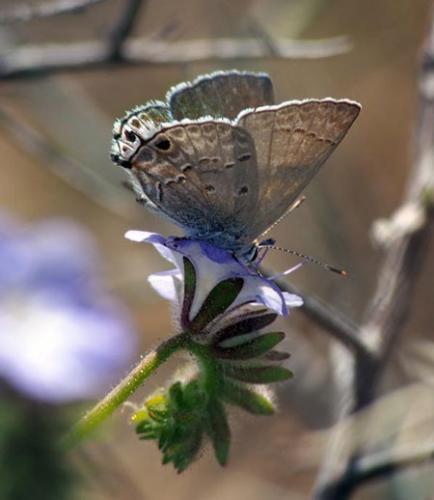Each Spring, a group of dedicated volunteers and park staff members conduct an annual butterfly count at Joshua Tree National Park to catalog species found inside the park. The park's wilderness areas offer many such opportunities for ongoing scientific discovery, and this year's effort yielded an exciting surprise: a new butterfly species for the park.
The primary range for mallow scrub-hairstreaks (Strymon istapa) runs from Mexico south to Brazil with only a few U.S. populations along the southern border in California, Texas, and Florida. In California, this butterfly species is found mainly in San Diego and Imperial counties, with only a few records from other adjacent counties. Until last month, this species had not been recorded in Joshua Tree National Park.
On March 29, 2014, several individuals of the species were observed near the Cottonwood area at Joshua Tree. A park spokesperson points out that "This exciting discovery invites continued scientific study, as well as the incorporation of citizen science at a young age."
Ranger Robb Hannawacker, one of the researchers for this butterfly count, reflected on his past experiences with the colorful insects. “As a twelve-year-old, I was made fun of for chasing after butterflies instead of focusing on ball games. ‘Hey Butterfly Boy', they'd say. Interestingly, my accuracy with a butterfly net made batting at softballs a breeze!”
There is considerable interest in the general population about butterflies, and they also play several important roles in the grand scheme of things. Because butterflies are very sensitive to changes in their environment, they are indicators of the overall health of ecosystems. Like the proverbial "canary in the mine shaft," they can serve as an early warning system when things begin to go awry.
New sightings of a species in any area, such as the discovery of a largely tropical species further north than usual, are also of interest in the field of phenology, a "segment of ecology focusing on the study of periodic plant and animal life-cycle events that are influenced by climate and seasonal change in the environment."
Butterflies are important pollinators for some plants, and during their various life stages provide food for birds and other species. The colorful insects may even hold the key to some important breakthroughs in science; meadow brown butterflies, for example, include a substance that has been found to have antibiotic qualities against Staphylococcus aureus (MRSA).
Finally, the simple pleasures butterflies bring to people should not be overlooked. Officials at the Smithsonian Institution's Natural History Museum in Washington, D.C., say the Live Butterfly Pavilion has been one of the Museum's most popular exhibits in the past five years. These gentle creatures quietly add interest, color and beauty to our lives, and contribute to our enjoyment of our world ... both in and outside of our parks.
Annual Butterfly Count Nets New Species at Joshua Tree National Park

This year's butterfly count yielded a new species at Joshua Tree National Park: several examples of mallow scrub-hairstreaks. NPS photo.
Support Journalism about National Parks!
National Parks Traveler is a 501(c)(3) nonprofit.
The Essential RVing Guide

The National Parks RVing Guide, aka the Essential RVing Guide To The National Parks, is the definitive guide for RVers seeking information on campgrounds in the National Park System where they can park their rigs. It's available for free for both iPhones and Android models.
This app is packed with RVing specific details on more than 250 campgrounds in more than 70 parks.
You'll also find stories about RVing in the parks, some tips if you've just recently turned into an RVer, and some planning suggestions. A bonus that wasn't in the previous eBook or PDF versions of this guide are feeds of Traveler content: you'll find our latest stories as well as our most recent podcasts just a click away.
So whether you have an iPhone or an Android, download this app and start exploring the campgrounds in the National Park System where you can park your rig.


Add comment